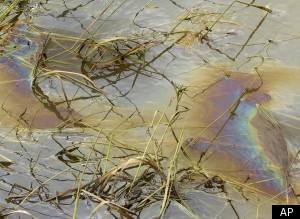
Exxon Mobil Corp. said Wednesday that it plans to use vacuum trucks to suck any remaining oil from a failed pipeline near Laurel that spilled an estimated 42,000 gallons of crude into the Yellowstone River.
Geoff Craft, the company’s incident commander on the spill, said the use of the vacuum trucks should prevent any more oil from polluting the scenic waterway.
It is not known how much oil is left in the 1,600-foot section of 12-inch pipeline that runs beneath the river. Draining that piece of the company’s Silvertip pipeline could begin by this weekend and take several days to complete, said Tom Livers, deputy director of the Montana Department of Environmental Quality.
The cause of the July 1 pipeline failure remains under investigation.
Hundreds of cleanup workers continue mopping up oil spread over dozens of miles downstream from the spill, and a congressional hearing on the accident is scheduled for Thursday in Washington, D.C.
About 100 people attended a community meeting on the spill Wednesday night in Laurel that was hosted by the Environmental Protection Agency.
Landowners along the river said they were unsure what steps to take with damaged pastureland, but there were fewer complaints about Exxon Mobil’s response to the spill than a similar meeting last week.
“No complaints, just questions,” said Jerry Hanson of Billings, who has been unable to graze his eight llamas on land he owns along the Yellowstone.
“I’ve heard I should not be cultivating that land for two years,” Hanson said. “No cleanup has started yet. What I’m concerned about is I’ve got 8 acres of pasture grass covered in some amount of oil. How much is too much? I have no idea.”
A representative of the Environmental Protection Agency said soil along the river is being tested and results will be available within a week to answer questions such as Hanson’s.
Only about nine barrels out of the estimated 1,000 barrels of oil that spilled have been recovered.
EPA on-scene coordinator Steve Merritt said Wednesday he did not expect that figure to increase much more.
“There’s no recoverable oil flowing on the water downstream,” Merritt said. “We are now very much in the shoreline cleanup mode.”
On the wildlife front, a U.S. Fish and Wildlife Service spokesman said two dead creatures have been found so far – a fish and a duck. Two toads, a snake and a bird with oil on them have been captured for rehabilitation, although some animals with small amounts of oil on them have been allowed to remain in the wild.
Gary Hammond with Montana Fish, Wildlife and Parks said the state is focused not on individual animals but on the potential for more profound damage to the river’s ecology. Representatives of the wildlife agency will join crews searching the river for areas with oil beginning this week, Hammond said.
“There’s a lot of places we haven’t been able to get to yet,” Hammond said. “We’re going to be ramping up that effort.”
Twenty people have reported health concerns related to the spill, said Yellowstone County Health officer John Felton. Many of those cases involved people suffering from nausea or breathing problems attributed to fumes given off by crude.
But officials say those fumes are dissipating as the oil degrades, breaks down. Felton said no one has been hospitalized and the public health risk is considered low.
Also Wednesday, Exxon Mobil submitted a revised cleanup plan after the EPA said a prior work plan from the company was incomplete.
Livers said the document was being reviewed to ensure it complies with state cleanup standards. Those standards are more stringent than federal cleanup rules.
The EPA has directed Exxon Mobil to clean up oil from the spill and remediate sections of fouled shoreline by Sept. 9.
Article courtesy of huffingtonpost.com

